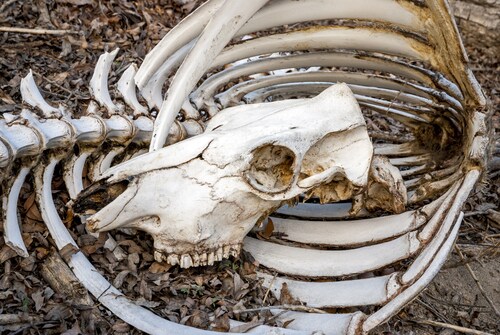 Bones are useful reservoirs of ancient biological information, storing remnants of cellular identity as well as gross physical characteristics from days of old. Recovery of genetic material from organisms ranging from Egyptian mummies to woolly mammoths is well documented and newsworthy. In addition to fueling the reincarnation business for returning extinct species to the world, investigators are also focusing on these remains to establish other scientific credentials, such as phylogenetic lineage and species identity.
Bones are useful reservoirs of ancient biological information, storing remnants of cellular identity as well as gross physical characteristics from days of old. Recovery of genetic material from organisms ranging from Egyptian mummies to woolly mammoths is well documented and newsworthy. In addition to fueling the reincarnation business for returning extinct species to the world, investigators are also focusing on these remains to establish other scientific credentials, such as phylogenetic lineage and species identity.
Wadsworth and Buckley (2014) used proteomic techniques and tested a novel enrichment method to investigate protein survival within the matrix of sub-fossil bovine bones gathered from various sites in the United Kingdom.1 In addition, they studied the effect of burial conditions on proteome decay in younger bones from an archaeological site in a warmer climate. Ancient boney proteomes, ranging in age from 4,000 years to 1.5 million years, were compared with modern bovines to assess changes in complexity with extreme age.
Choosing 19 bovine sub-fossil bone specimens, Wadsworth and Buckley carefully drilled into cortical tissue to minimize contamination and extracted interior bone powder. From previous studies, the researchers were already aware that bone collagens would be over-represented in the final sample for proteomic analysis, masking the identity of less abundant, but potentially more informative, non-collagenous proteins (NCPs) that might be present. For this reason, they chose to pre-treat samples with a bacterial collagenase before using shotgun proteomics for the initial proteome identification.
To validate their pre-treatment step, the scientists used seven ancient samples and one modern sample. First, they demineralized the samples before applying the collagenase pre-treatment step, subsequently digesting the samples overnight using trypsin, as per standard methodology. Demineralized samples were also prepared with trypsin digestion alone for comparison. The team then analyzed the protein digests by liquid chromatography–tandem mass spectrometry (LC-MS/MS) using a Dionex Ulitmate 3000 column coupled to an Orbitrap Elite hybrid ion trap-Orbitrap mass spectrometer (Thermo Scientific), next using Mascot to search peptide mass data against the SwissProt database in order to identify proteins. The two researchers then manually sorted the proteins identified with Bos and Bison databases to create the ancient bone proteome. Researchers used STRING (Search Tool for the Retrieval of Interacting Genes/Proteins) to list protein functional relationships.
Collagenase treatment prior to LC-MS/MS was successful in removing over-abundant collagen proteins but significantly reduced proteome complexity in modern bone. The researchers identified only 18 NCPs following collagenase treatment, compared to 48 in untreated samples. Furthermore, in addition to reducing proteome complexity, pre-treatment had little effect on collagens in the seven ancient bones. NCPs were not detected at all in three of the ancient samples subjected to collagenase pre-treatment. In one sample, more than four times the number of NCPs were identified when collagenase treatment was not used.
Having investigated and refined their methodology, the researchers processed all 19 ancient bone samples, reliably recovering proteins up to 900,000 years of age and identifying 50 unique proteins among them. Although bone collagens were the most abundant, the majority of proteins (44) were NCPs—from blood or serum (16), extracellular matrix (12), intracellular (10) and bone (osteonectin and osteomodulin).
Proteome complexity varied inversely with age and was affected by burial site history. For example, samples from warmer climates contained fewer or no NCPs, whereas a sample embedded in the seabed yielded the most complex NCP proteome. In the latter, the authors speculate that this is due to an unfavorable decomposition environment and preservation of biomaterial. Younger bones contained more complex proteomes, with a majority of proteins surviving into the Late Pleistocene.
The researchers identified Alpha-2-HS-glycoprotein (A2HSG) and serum albumin as the most useful NCP survivors because they were found most consistently in a wide range of samples. Each of these show species-specific variations and are good potential markers for phylogenetic determination and species comparison of remains. The authors note that A2HSG is the preferred marker because it is less prone to contamination than serum albumin, and its smaller molecular size makes it more suitable for MS investigation.
Reference
1. Wadsworth, C., and Buckley, M. (2014, March) “Proteome degradation in fossils: Investigating the longevity of protein survival in ancient bone,” Rapid Communications in Mass Spectrometry, 28 (pp. 605–15), doi: 10.1002/rcm.6821.
Post Author: Amanda Maxwell. Mixed media artist; blogger and social media communicator; clinical scientist and writer.
A digital space explorer, engaging readers by translating complex theories and subjects creatively into everyday language.
Leave a Reply